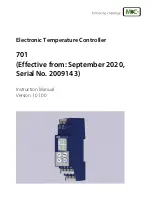
16
8-9. Start-up time output limiting (option)
This circuit can be used in two ways:
•
To limit output when power is supplied
Use it by short-circuiting terminals 7 (DI-COM) and 9 (DI2).
Care should be taken because turning the power on when terminals 7 (DI-COM) and 9 (DI2) are open results in a shortage of output, as
the instrument continues to run with limited output.
•
To limit output in synchronization with external sequence
In order to change the load without turning off power, it is possible to reduce output by connecting a switching signal (external sequence
contact) to terminals 7 (DI-COM) and 9 (DI2), and then short-circuiting the terminals.
8-10. Soft start time
The instrument can be adjusted to have the characteristic shown below at the rising edge of the control signal, or at the start of output when
power is turned on.
The time until the output changes (to reach 90% from 0) with respect to the rising edge of the control signal (from 0 to 100%) can be
adjusted in the range of about 1 to 30 seconds.
■ To limit output when power is supplied
Leave terminals 7 (DI-COM) and 9 (DI2) short-circuited.
■ To limit output in synchronization with external signal
Connect terminals 7 (DI-COM) and 9 (DI2) to external signals.
If terminals 7 (DI-COM) and 9 (DI2) are open, the output continues to be limited.
Start-up time output limit time
Controller
External sequence
contact
External sequence
contact
Cu
rre
n
t
Time
Rated value
Output current without function
Saved current with function
Output voltage
Control time 1 to 60 seconds
Soft start 1 to 30 seconds
Start-up time output limit level
Control output 0 to 60%









































